Moments in time - the Austrian Grand Prix
In our series exploring the history of Grands Prix through a selection of iconic images, we focus the lens on Austria, which returns to the calendar this year after an 11-year absence. This trip down memory lane takes in the inaugural race on Zeltweg’s bumpy airfield, a last-lap battle to the flag, one of the most controversial finishes of all time, and more…
Bandini survives race of attrition for only win, Zeltweg, 1964
When the teams arrived at Zeltweg airfield for the inaugural world championship Grand Prix in Austria they found a track riddled with bumps. The situation was so bad that several drivers experienced suspension failures during practice and then, more critically, during the race itself. John Surtees and Dan Gurney both suffered race-ending suspension malfunctions when leading, while the driveshaft on frontrunner Jim Clark’s Lotus also gave way. These incidents helped Lorenzo Bandini, pictured here passing a pit board-wielding Ferrari mechanic, to come through from seventh on the grid for his first (and only) Formula One victory.
(© Sutton Images)
Ickx leads Ferrari one-two on first F1 visit to the Osterreichring, 1970
There were six years between the world championship’s first visit to Austria and the country’s return to the calendar. But in the intervening period the race organisers had sensibly dispensed with the bumpy airfield circuit at Zeltweg and built a far superior 5.9km track in the surrounding valley. The Osterreichring was searingly fast and spectacularly undulating and as you can see in this picture, it attracted thousands of fans. Unfortunately for the locals, home favourite and polesitter Jochen Rindt would retire early on with engine failure, leaving the coast clear for the scarlet Ferraris of Jacky Ickx (leading) and Clay Regazzoni to take a comfortable one-two.
(© Sutton Images)
Ecstatic Fittipaldi edges closer to title with hard-fought victory, Osterreichring, 1972
Emerson Fittipaldi entered the 1972 Austrian Grand Prix knowing that victory would all but guarantee him a maiden title in just his second full year in motorsport’s top echelon. Armed with the perfectly honed Lotus 72, the popular Brazilian had already taken victory in Spain, Belgium and Britain and at the Osterreichring he saw off the challenge of McLaren’s Denny Hulme to win once more. As he celebrated on the podium, Fittipaldi knew that even if he failed to score in the remaining three races, Hulme would have to win every one to snatch the title away from him. He didn’t and victory at the next race in Italy saw 25-year-old Fittipaldi become F1 racing's then-youngest champion.
(© Sutton Images)
Brambilla wins… then spins! Osterreichring, 1975
For three successive years in the Seventies, Austria was the scene of an unexpected result, starting with Vittoria Brambilla’s triumph in the rain-shortened 1975 race. The March driver used his wet-weather prowess to jump from eighth on the grid into the lead by the time that bad weather brought an early end to proceedings at the end of the 29th lap. But the really memorable moment came as Brambilla was - much to his surprise - shown the chequered flag. The Italian jubilantly raised his arm from the cockpit in celebration, only to lose control of his bright orange car and slide nose-first into the barriers. Luckily, as this picture shows, Brambilla was able to nurse his damaged machine around a victory lap, although his triumph will forever be tinged in sadness, coming on the same day as American driver Mark Donohue’s tragic pre-race accident.
(© Sutton Images)
Watson wins for Penske - but loses his beard! Osterreichring, 1976
In 1976, for the second year in a row, the Austrian Grand Prix threw up something of a surprise result as Britain’s John Watson claimed his maiden world championship victory driving for Roger Penske’s eponymous team. The win had particular poignancy for the American team owner, coming just a year after the squad’s star driver Mark Donohue had crashed at the same circuit and eventually succumbed to his injuries. After the race, Watson, seen here climbing the steep hill at the end of the start/finish straight, shaved off his trademark beard having promised Penske he would do it if the team won a race. Sadly, the squad would never win again in Grand Prix racing as, at the end of the season, Penske decided to concentrate his racing efforts in the USA, to great effect as it turned out. His team remain the last registered in the United States to win in F1 competition.
(© Sutton Images)
De Angelis holds off Rosberg in thrilling finale, Osterreichring, 1982
After the death of Gilles Villeneuve in Belgium and the serious injuries sustained by Didier Pironi in Germany, Formula One racing was desperately in need of a lift by the time the 1982 Austrian Grand Prix rolled around, and that’s just what Elio de Angelis and Keke Rosberg delivered. In reality, with the high altitude favouring the turbo runners, neither Cosworth-powered driver should have been in contention for the win, but as each turbo car dropped out or was delayed, the hard-charging De Angelis found himself in the lead. But behind the Italian, Rosberg was on a charge of his own and closed in to such an extent that by the start of the 53rd and final lap, the Finn’s Williams was just 1.6s behind the Lotus. At the final corner there was nothing in it, but which of the two drivers would score their maiden win? In the end there was just 0.050s in it as De Angelis (pictured right, arm out of cockpit) squeaked over the line in front. But it wasn’t all bad news for Rosberg - two weeks later he’d win in Switzerland to put him firmly on course for the world championship glory.
(© LAT Photographic)
Lauda defeats Piquet to finally seal home win, Osterreichring, 1984
In Jochen Rindt and Niki Lauda, Austria could rightly lay claim to two of the finest drivers of the Sixties/Seventies, yet it wasn’t until 1984 that the country finally got its first, and as yet only, home winner. Granted, Rindt only had two chances of victory before his sad passing, but Lauda had tried (and failed) to win on ten previous occasions before finally reaching the top step of the Osterreichring podium. This picture, which shows Nelson Piquet’s Brabham leading Lauda’s McLaren, was taken just before the pair came up to lap the ponderous Ferrari of Michele Alboreto, 11 laps from the flag. Piquet hesitated behind the Italian’s red car and in an instant Lauda went by and into the lead, much to the crowd’s delight. He held on to win by 23 seconds.
(© Sutton Images)
Oops! Coulthard clash slows Hakkinen’s title charge, A1 Ring, 1999
McLaren’s Mika Hakkinen arrived in Spielberg for the 1999 Austrian Grand Prix with an eight-point lead in the world championship and the knowledge that main title rival Michael Schumacher was side-lined indefinitely with a broken leg. The only man who could now seemingly stop the Finn claiming a second successive crown was Schumacher’s Ferrari team mate Eddie Irvine, but given that he couldn’t qualify within a second of Hakkinen’s pole time, his threat looked minimal. But on race day the unthinkable happened - having made a good getaway, Hakkinen led into Turn 2, only to be punted into a spin by team mate David Coulthard. Having dropped to the back of the field, Hakkinen made his way up to third by the flag, but by that stage Irvine had jumped Coulthard and cut the Finn’s points lead to just two.
(© Sutton Images)
Sato’s lucky escape, A1 Ring, 2002
Japanese driver Takuma Sato (in the yellow Jordan) was extremely thankful for F1 racing’s high safety standards after being violently sideswiped by Nick Heidfeld’s Sauber (pictured to the left of Sato’s car) on lap 26 of the 2002 Austrian Grand Prix. Sato, who escaped the horror smash with just bruising, was rounding the Turn 2 hairpin following a safety car re-start when he was suddenly speared by Heidfeld’s out-of-control car. "Maybe I pressed the pedal too hard while the brakes were still too cool,” said Heidfeld. “The car got away from me and next thing I knew I was going backwards down the grass." Unsurprisingly, another safety car period followed…
(© Sutton Images)
Barrichello controversially cedes victory to Schumacher, A1 Ring, 2002
Don’t be fooled by this picture - Rubens Barrichello may well be holding the 2002 Austrian Grand Prix winner’s trophy aloft, but it was his sheepish-looking Ferrari team mate Michael Schumacher who crossed the finishing line in first. Having led for all but one of the race’s 71 laps, Barrichello controversially slowed coming out of the final corner having been asked to let his German team mate take the win and collect the maximum number of world championship points. Unimpressed by such a move, the Austrian fans booed loudly as Schumacher and Barrichello embarrassingly climbed onto the podium. But worse was to follow - Ferrari were hit with a substantial fine for breaching podium protocol (Schumacher and Barrichello shared the top step), whilst the FIA rushed through a rule banning team orders.
(© Sutton Images)
Next Up
Related Articles
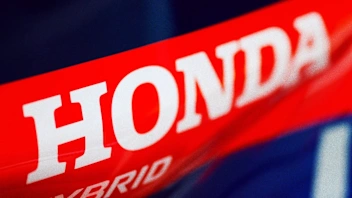 Honda reveal details around power unit launch
Honda reveal details around power unit launch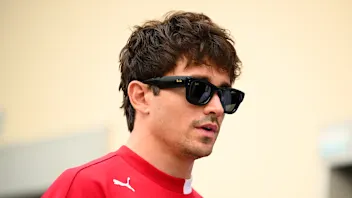 Leclerc calls Ferrari’s focus shift to 2026 a ‘no-brainer’
Leclerc calls Ferrari’s focus shift to 2026 a ‘no-brainer’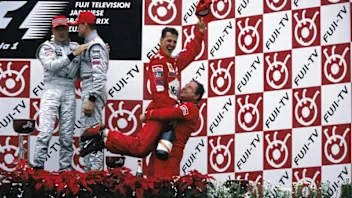 The most iconic recent championship celebrations
The most iconic recent championship celebrations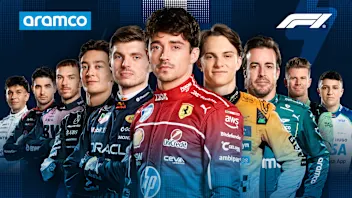 Power RankingsWho did our judges rank as the best F1 driver of 2025?
Power RankingsWho did our judges rank as the best F1 driver of 2025?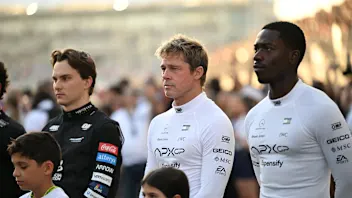 ExclusiveHow APXGP was brought to life by costume designer Julian Day
ExclusiveHow APXGP was brought to life by costume designer Julian Day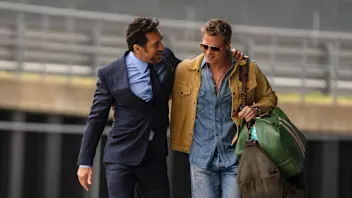 10 ways to get your Formula 1 fix during the winter break
10 ways to get your Formula 1 fix during the winter break